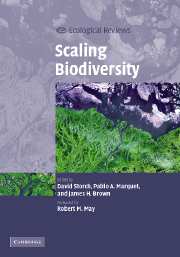Book contents
- Frontmatter
- Contents
- List of contributors
- Foreword by Robert M. May (Lord May of Oxford)
- Preface
- 1 Introduction: scaling biodiversity – what is the problem?
- PART I Spatial scaling of species richness and distribution
- PART II Alternative measures of biodiversity: taxonomy, phylogeny, and turnover
- PART III Scaling of biological diversity with energy and the latitudinal biodiversity gradient
- PART IV Processes, perspectives, and syntheses
- 16 Spatiotemporal scaling of species richness: patterns, processes, and implications
- 17 Scaling biodiversity under neutrality
- 18 General patterns in plant invasions: a family of quasi-neutral models
- 19 Extinction and population scaling
- 20 Survival of species in patchy landscapes: percolation in space and time
- 21 Biodiversity power laws
- Index
- Plate section
- References
18 - General patterns in plant invasions: a family of quasi-neutral models
Published online by Cambridge University Press: 05 August 2012
- Frontmatter
- Contents
- List of contributors
- Foreword by Robert M. May (Lord May of Oxford)
- Preface
- 1 Introduction: scaling biodiversity – what is the problem?
- PART I Spatial scaling of species richness and distribution
- PART II Alternative measures of biodiversity: taxonomy, phylogeny, and turnover
- PART III Scaling of biological diversity with energy and the latitudinal biodiversity gradient
- PART IV Processes, perspectives, and syntheses
- 16 Spatiotemporal scaling of species richness: patterns, processes, and implications
- 17 Scaling biodiversity under neutrality
- 18 General patterns in plant invasions: a family of quasi-neutral models
- 19 Extinction and population scaling
- 20 Survival of species in patchy landscapes: percolation in space and time
- 21 Biodiversity power laws
- Index
- Plate section
- References
Summary
Introduction
Biological invasions, i.e. cases when an alien species increases and spreads in a new region, are of enormous practical interest (Elton, 1958; Groves, 1989; Levin, 1989). Empirical studies show large differences between different community types in the number of alien species found there (Rejmánek, Richardson & Pyšek, 2005). It is therefore believed that the fact whether a community is invasible can tell us something on the “internal working” of the invaded communities; in particular, understanding why a particular species establishes in a particular community can shed light on the ecological processes structuring a community (Elton, 1958; Shea & Chesson, 2002; Moore et al., 2001). Experimental studies have shown that invasion success may be affected by processes such as disturbance (Fox & Fox, 1986; Mooney & Drake, 1986; Burke & Grime, 1996), fluctuating resources (Davis, Grime & Thompson, 2000), or growth rate ranking of species (Rejmánek & Richardson, 1996).
In theoretical studies, invasibility has been routinely used as a stability measure in Lotka–Volterra or similar systems (Case, 1990; Law & Morton, 1996; Moore et al., 2001; Byers & Noonburg, 2003). Nevertheless there is a certain gap between theoretical understanding of community invasibility (Shea & Chesson, 2002) and empirical studies of single invasions. The latter inevitably study events that are singular in their nature (Rejmánek et al., 2005). Studies of individual invasions typically concentrate on specific biological traits of the invasive species that are essential for their invasion success.
- Type
- Chapter
- Information
- Scaling Biodiversity , pp. 376 - 395Publisher: Cambridge University PressPrint publication year: 2007
References
- 1
- Cited by



